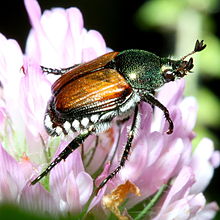Popillia japonica
| Japanese beetle | |
|---|---|
 |
|
| Scientific classification | |
| Kingdom: | Animalia |
| Phylum: | Arthropoda |
| Class: | Insecta |
| Order: | Coleoptera |
| Family: | Scarabaeidae |
| Genus: | Popillia |
| Species: | P. japonica |
| Binomial name | |
|
Popillia japonica Newman, 1841 |
|
The Japanese beetle (Popillia japonica) is a common species of beetle. It is about 15 mm (0.6 in) long and 10 mm (0.4 in) wide, with iridescent copper-colored elytra and green thorax and head. It is not very destructive in Japan, where it is controlled by natural predators, but in North America, it is a serious pest of about 200 species of plants, including rose bushes, grapes, hops, canna, crape myrtles, birch trees, linden trees, and others.
It is a clumsy flier, dropping several centimeters when it hits a wall. Japanese beetle traps, therefore, consist of a pair of crossed walls with a bag or plastic container underneath, and are baited with floral scent, pheromone, or both. However, studies conducted at the University of Kentucky and Eastern Illinois University suggest beetles attracted to traps frequently do not end up in the traps, but alight on plants in the vicinity, thus causing more damage along the flight path of the beetles and near the trap than may have occurred if the trap were not present.
These insects damage plants by skeletonizing the foliage, that is, consuming only the leaf material between the veins, and may also feed on fruit on the plants if present.
As the name suggests, the Japanese beetle is native to Japan. The insect was first found in the United States in 1916 in a nursery near Riverton, New Jersey. The beetle larvae are thought to have entered the United States in a shipment of iris bulbs prior to 1912, when inspections of commodities entering the country began. "The first Japanese beetle found in Canada was in a tourist's car at Yarmouth, arriving in Nova Scotia by ferry from Maine in 1939. During the same year, three additional adults were captured at Yarmouth and three at Lacolle in southern Quebec."
...
Wikipedia
